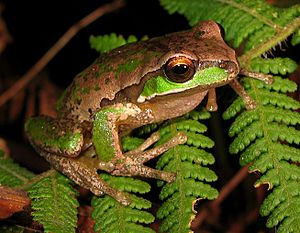New England tree frog facts for kids
Quick facts for kids New England tree frog |
|
|---|---|
 |
|
| Conservation status | |
| Scientific classification | |
| Genus: |
Ranoidea
|
| Species: |
subglandulosa
|
| Synonyms | |
|
|
The New England tree frog (Ranoidea subglandulosa) is a type of tree frog that lives in Australia. It's also known as the gold-striped tree frog, sublime tree frog, or glandular tree frog.
Even though its name includes "New England," this frog doesn't live in the New England area of the United States. Instead, it lives on the New England Tablelands in Australia. You can find it near the Great Dividing Range in Queensland and New South Wales. These frogs live in places that are more than 600 meters (about 2,000 feet) above sea level.
What Does It Look Like?
Adult male New England tree frogs are about 4.0 cm (1.6 inches) long. The adult females are a bit bigger, reaching about 5.0 cm (2.0 inches) in length.
These frogs can be green or brown on their backs. Their sides are usually green. They have a clear white stripe running along each side of their body. You might also notice bright orange patches on parts of their sides and legs, which makes them quite colorful!
Tadpoles: A Special Surprise!
The tadpoles of the New England tree frog are about 3.5 cm (1.4 inches) long. What makes them really special is how different they are from other tree frog tadpoles.
Most tadpoles have tiny teeth or beak-like mouths to scrape food. But these tadpoles don't! Instead, they have small, tentacle-like parts near their mouths. Scientists are still trying to figure out exactly what these unique tadpoles eat. It's a mystery!
Why Is This Frog in Danger?
Sadly, the New England tree frog is considered vulnerable. This means it's in some danger of dying out if we don't protect it.
Scientists believe there are a few reasons for this. One big reason is human activity. People sometimes let animals graze (eat grass) where these frogs live, which can damage their habitat. Also, trees are sometimes cut down from the forests where the frogs make their homes.
Another problem comes from invasive species. These are animals that are brought into an area where they don't naturally belong. For example, fish like trout have been introduced to some areas. These trout can eat the eggs and young tadpoles of the New England tree frog, making it harder for them to survive.
Scientists say this frog is related to the Ranoidea citropa.
See also
 In Spanish: Litoria subglandulosa para niños
In Spanish: Litoria subglandulosa para niños


